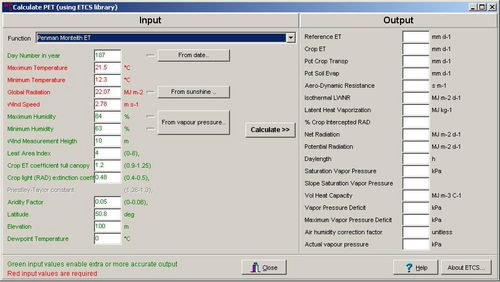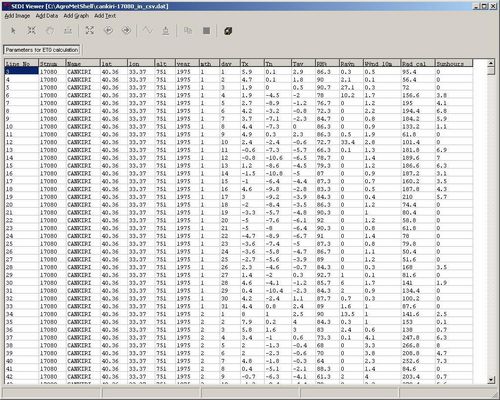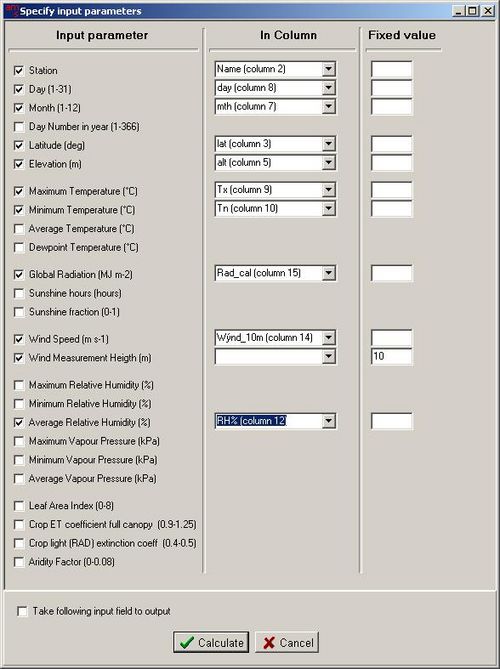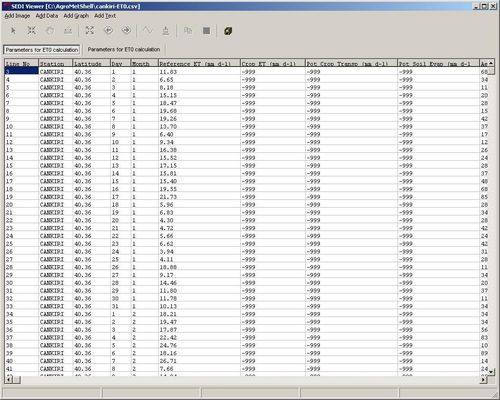(Difference between revisions)
| Revision as of 08:32, 4 August 2006 Peter (Talk | contribs) (→'''Chapter 11. Development of ET<sub>0</sub> computation procedure.''') ← Previous diff |
Current revision Peter (Talk | contribs) |
||
| Line 1: | Line 1: | ||
| <blockquote> | <blockquote> | ||
| - | ='''Chapter 11. Development of ET<sub>0</sub> computation procedure.'''= | + | __NOTOC__ |
| + | ==3.2. Computing the reference evapotranspiration ET<sub>0</sub>.== | ||
| + | ------------------------------------ | ||
| + | {| style="background-color:#F5F5F5; border-collapse:collapse" cellspacing="7" border="1" bordercolorlight="#0000FF" bordercolordark="#0000FF"> | ||
| + | |style="border-style: solid; border-width: 1px"|''Peter Hoefsloot'' | ||
| + | |- | ||
| + | |} | ||
| + | |||
| + | Since 1972, FAO has used the modified Penman method to estimate the evapotranspiration of a reference crop (Frere and Popov, 1986). Recent comparative studies have however shown the best-performing combination equation of the Penman-Monteith approach which has been adopted by FAO in the methodologies for estimating the crop water requirements. The reference evapotranspiration ETo is defined as the rate of evapotranspiration from a hypothetical crop of 12 cm height, with canopy resistance of 69 [s m-1] and a canopy reflection coefficient (albedo) of 0,23. | ||
| - | Potential evapotranspiration (ET<sub>0</sub>) is a vital input to Water Balance calculations, which in turn are a vital part in Crop forecasting. The parameters needed to calculate ET<sub>0</sub> are the following: | + | Potential evapotranspiration (ET<sub>0</sub>) is a vital input to Water Balance calculations, which in turn is a vital part in Crop Forecasting. The parameters needed to calculate ET<sub>0</sub> are listed below. The data should be provided in daily form. This will result in daily ET<sub>0</sub> values that have to be aggregated to dekads. |
| <blockquote> | <blockquote> | ||
| - | {| border="1" class="wikitable" | + | {|"class=prettytable" cellpadding="5" border="1" style="border-collapse:collapse" |
| | '''Parameter group''' | | '''Parameter group''' | ||
| | '''Parameters''' | | '''Parameters''' | ||
| Line 13: | Line 21: | ||
| | Maximum and minimum temperature | | Maximum and minimum temperature | ||
| | Some ET<sub>0</sub> calculation methods use average temperature only. AgrometShell needs both minimum and maximum temperatures. | | Some ET<sub>0</sub> calculation methods use average temperature only. AgrometShell needs both minimum and maximum temperatures. | ||
| - | |- | ||
| |- | |- | ||
| | '''Radiation (MJ/m<sup>2</sup>)''' | | '''Radiation (MJ/m<sup>2</sup>)''' | ||
| Line 21: | Line 28: | ||
| | '''Wind Speed (m/sec)''' | | '''Wind Speed (m/sec)''' | ||
| | Wind speed at 2 meters | | Wind speed at 2 meters | ||
| - | | Formulas are available to convert wind speed for other heights (e.g. 10 meters) into a 2 meter value. | + | | Formulas are available to convert wind speed for other heights (e.g. 10 meters) into 2 meter values. |
| |- | |- | ||
| + | |- | ||
| + | | '''Optional: relative humidity (%)''' | ||
| + | | Maximum and minimum relative humidity during the day. | ||
| + | | Although this parameter is not essential it improves the ET<sub>0</sub> calculations substantially. In AgrometShell relative humidity can be calculated from vapour pressure measurements. | ||
| + | |- | ||
| + | |} | ||
| + | </blockquote> | ||
| + | |||
| + | The ET calculation routine incorporated in AgrometShell have been developed by Dr. Marcello Donatelli (http://www.sipeaa.it/mdon/). He publishes a number of his agrometorology methods on the web (for on-line ET calculation examples see: http://www.sipeaa.it/wfet/). | ||
| + | |||
| + | |||
| + | ===Checking data availability using AgrometShell=== | ||
| + | |||
| + | In order to check whether enough input data are available to calculate ET<sub>0</sub> AgrometShell is used. In AgrometShell activate the ''Tools – Potential ET – Manual'' function. | ||
| + | |||
| + | <blockquote> | ||
| + | {|"class=prettytable" cellpadding="15" border="1" style="border-collapse:collapse" | ||
| + | |width="225"|The manual ET<sub>0</sub> calculation window. On the left side the input parameters are specified. On the right side, the outcome is generated, once the ''Calculate>>'' button is pressed. Clear the parameters on the left side of the screen and fill them with your own data. Try to calculate. If a value is calculated for the ET<sub>0</sub>, the top right value (Reference ET) is filled. The ''From…'' buttons make it possible to calculate the following parameters in an alternative way: | ||
| + | * Day number in the year | ||
| + | * Global radiation | ||
| + | * Vapour pressure | ||
| + | ||[[Image:graph22.jpg|500px|]] | ||
| + | |} | ||
| + | </blockquote> | ||
| + | |||
| + | ===Calculating ET<sub>0</sub> using external ASCII files.=== | ||
| + | The ET<sub>0</sub> calculations can be performed in AgrometShell using data from the database or data in external ASCII files. In this paragraph the second option will be outlined. | ||
| + | |||
| + | <blockquote> | ||
| + | {|"class=prettytable" cellpadding="15" border="1" style="border-collapse:collapse" | ||
| + | |width="225"|The input file should be in FAO format. You can check this by displaying the file with the ''View – Data – As columns'' function ||[[Image:graph23.jpg|500px|]] | ||
| + | |---- | ||
| + | |width="225"|Display of the FAO format file in the Agrometshell Viewer. The headers explain the column data. || [[Image:graph24.jpg|500px|]] | ||
| + | |---- | ||
| + | |width="225"|Now activate the ''Tools-Potential ET-From file'' function|| [[Image:graph25.jpg|500px|]] | ||
| + | |---- | ||
| + | |width="225"|Explain the lay-out of the file to AgrometShell with the following screen|| [[Image:graph26.jpg|500px|]] | ||
| + | |---- | ||
| + | |width="225"|View the results. Notice the ET<sub>0</sub> column (column 6)|| [[Image:graph27.jpg|500px|]] | ||
| |} | |} | ||
| </blockquote> | </blockquote> | ||
| + | After calculating the ET<sub>0</sub> values need to be imported into AgrometShell using the [[ASCIIDataImport|procedure on ASCII import]]. | ||
| - | * Temperatures : minimum and maximum in degrees celcius | + | Subsequently, the data are aggregated from daily to dekadal values using then function ''Database-Calculate-Actual-Monthly from dekadal from daily''. |
| - | * Radiation. Radiation can be calculated quite accurately from the number of sunshine hours (or sunshine fraction) accompanied by Day number in the year | + | |
| Line 35: | Line 81: | ||
| + | ------------------------- | ||
| <blockquote> | <blockquote> | ||
Current revision
[edit]3.2. Computing the reference evapotranspiration ET0.
Peter Hoefsloot Since 1972, FAO has used the modified Penman method to estimate the evapotranspiration of a reference crop (Frere and Popov, 1986). Recent comparative studies have however shown the best-performing combination equation of the Penman-Monteith approach which has been adopted by FAO in the methodologies for estimating the crop water requirements. The reference evapotranspiration ETo is defined as the rate of evapotranspiration from a hypothetical crop of 12 cm height, with canopy resistance of 69 [s m-1] and a canopy reflection coefficient (albedo) of 0,23.
Potential evapotranspiration (ET0) is a vital input to Water Balance calculations, which in turn is a vital part in Crop Forecasting. The parameters needed to calculate ET0 are listed below. The data should be provided in daily form. This will result in daily ET0 values that have to be aggregated to dekads.
Parameter group Parameters Remarks Temperature Maximum and minimum temperature Some ET0 calculation methods use average temperature only. AgrometShell needs both minimum and maximum temperatures. Radiation (MJ/m2) Global radiation Global radiation can be calculated from sunshine hours or sunshine fraction accompanied by latitude and day in the year (Julian Date). Wind Speed (m/sec) Wind speed at 2 meters Formulas are available to convert wind speed for other heights (e.g. 10 meters) into 2 meter values. Optional: relative humidity (%) Maximum and minimum relative humidity during the day. Although this parameter is not essential it improves the ET0 calculations substantially. In AgrometShell relative humidity can be calculated from vapour pressure measurements. The ET calculation routine incorporated in AgrometShell have been developed by Dr. Marcello Donatelli (http://www.sipeaa.it/mdon/). He publishes a number of his agrometorology methods on the web (for on-line ET calculation examples see: http://www.sipeaa.it/wfet/).
[edit]Checking data availability using AgrometShell
In order to check whether enough input data are available to calculate ET0 AgrometShell is used. In AgrometShell activate the Tools – Potential ET – Manual function.
[edit]Calculating ET0 using external ASCII files.
The ET0 calculations can be performed in AgrometShell using data from the database or data in external ASCII files. In this paragraph the second option will be outlined.
After calculating the ET0 values need to be imported into AgrometShell using the procedure on ASCII import.
Subsequently, the data are aggregated from daily to dekadal values using then function Database-Calculate-Actual-Monthly from dekadal from daily.






